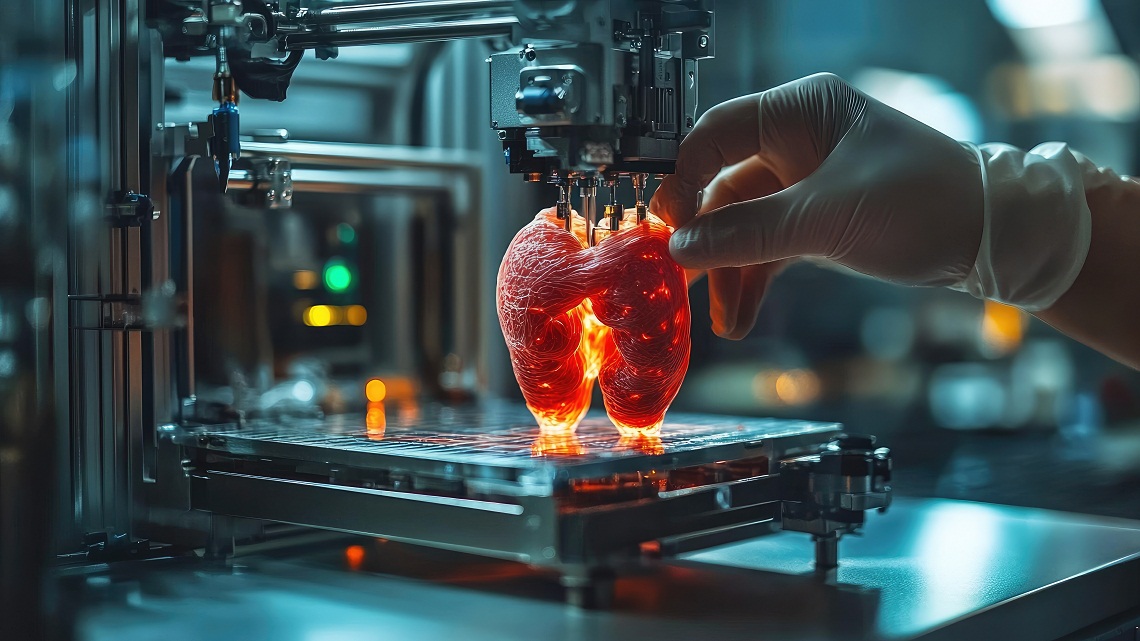
3D bioprinting is state-of-the-art technology that gives us the ability to produce living tissues based on computer-controlled printing methods and directions. Bioprinting differs from conventional manufacturing processes which incorporate biology, engineering, and material science to recreate the structure and function of human tissues. 3D bioprinting has rapidly established itself as a major pillar of biomedical innovation, as modern medical practices shift towards more personal therapies and interventions, advanced regeneration of human organs, disease models, this technology has become an innovative solution. Research developers, clinicians and companies in biotech sectors are advancing development to harness the unprecedented offerings 3D bioprinting presents—producing patient specific tissues, addressing organ shortages, and substantially improving the degree of accuracy of drug testing.
In this blog, we will describe what 3D bioprinting is, history of emergence, how it works, and important types used in today’s healthcare landscape.
What Is 3D Bioprinting?
3D bioprinting refers to a type of adaptive manufacturing in creation of three-dimensional biologically living tissues by depositing living cells, biomaterials layer, and growth factors. Bioprinting, unlike 3D printing of objects, not only seeks to construct a structure but to promote cell survival, tissue development, and biological performance.
What Makes it Different
Unlike other printing methods using plastics or metals, bio printing involves creating a 3D blue print, and the ink of a bioprinter is suspended in hydrogels that replicate the extracellular environment.
The printed object also supports biological activities, such as nutrient exchange, cell signaling, and tissue reconstruction. After printing, the structures are often utilized as bioactive scaffolds, indicating that they require incubation to mature from a printed structure into functional tissues.
Key Components
- “Bioink” is a type of hydrogels consisting of either patient or engineered tissue cells suspended in biomaterials such as collagen, alginate, or gelatin.
- Bioprinters, which can be a modified 3D printer or a specialized bioprinter, have unique capabilities, including temperature control, sterile chambers, and multi-nozzle capabilities.
- Bioreactors provide important mechanical and chemical signals to facilitate growth, remodeling, and ultimately to stabilize its structure.
- Many bioprinter manufacturers have adopted real-time optical monitoring; while there are not many in-depth explanations, this is a capability the bioengineering community has yet to have a lot of research around.
History of 3D Bioprinting
In 1980s, the initial breakthrough in 3D bioprinting has emerged with an investigation regarding depositing biomedical materials in printers. As the beginning of early 2000s, researches remoulded the purpose of inkjet printers to eject living cells in forms of droplets, and the experiment witnessed that many cells are survived mechanical stress, catalyzed for the further developments of printing biology. The research also concluded that, cells naturally self-organize after thee disposition, eliminated a critical precison requirements in printing.
How 3D Bioprinting Works
3D bioprinting works with a structured and multi-step window. It includes:
- Pre-Bioprinting Stage
- Imaging tools like CT, MRI, or micro-CT are used to trace details related to anatomy
- Once it’s done, a digital CAD format model is developed even including the micro scale features
- The bioinks are specifically designed in accordance with choosel type of cell, biomaterials and nutrients
- Bioprinting Stage
- Using a bioprinter, deposit the ink layer by layer manner, considering with the digital pattern
- In this stage, the temperature, pressure, and nozzle speed are strictly mmaintains controlled
- Sumultaneously, carries out the printing of support materials in order to balance and maintain structure.
- Post-Bioprinting Stage
- After, bioprinting the constructs such as a 3D print human heart, or other organs are placed in bioreactors for incubation, where it is supplies with nutrients, oxygen and biochemical signals for further development.
- The cells then proliferate, differentiate, and organize into specific structures
- Streching, such mechanical stimulations accelerates the maturing of constructs
The recent advancements in biorectors made psychological simulations possible including the breathing cycle or heartbeat, helps for more natural functioning.
Types of 3D Bioprinting
- Inkjet Bioprinting
- Use of drop-based deposition.
- Suitable for soft tissues and high-throughput patterns.
- Affordable but constrained to bioinks of low viscosity.
- Extrusion-Based Bioprinting
- The structural tissues method that is most commonly known.
- Makes use of viscous bioinks that are suitable for the production of cartilage, bone scaffolds, and organ-like constructs.
- Enables continuous deposition for shapes that are visually and structurally stronger.
- Laser-Assisted Bioprinting
- Employs a laser pulse to move the bioink locally with the utmost precision.
- Allows for excellent cell viability because no mechanical force is involved.
- It is best to use for printing neural, vascular, or fragile cells.
- Stereolithography (SLA) Bioprinting
- Implements regulated light to harden the photosensitive biomaterials.
- Very precise and detailed—pretty much the main uses are scaffolds and micro-architectures.
- Not very suitable for cell-dense constructs, but structural support can be taken as an advantage.
Conclusion
3D bioprinting, is a leading driver of technology innovation in the medical domain, enabling organ creation and advanced disease model in an incredible precision. The 3D technology has come a long way from its small-scale experimental emergence to unprecedented advancements in regenerative medicine, drug development, and personalized healthcare. The ultimate goal of the field is to be able to print fully functional, patient-specific organs, which would be a game changer for millions of people in need of a different treatment route. The rise of 3D bioprinting is not only a reflection of technological advancement but also a significant change that indicates the future where biology and engineering will be combined to address the most complex challenges of medicine.
To read more, visit The Healthcare Insights.
